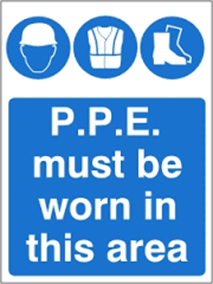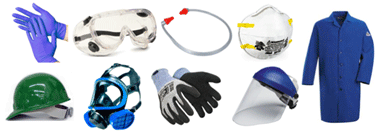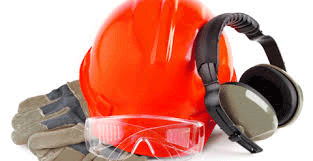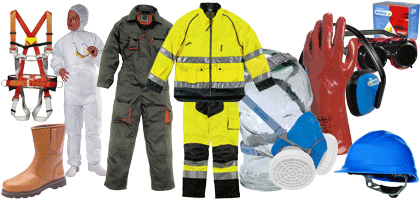Pe rsonal Protective Equipment (P.P.E) at work
rsonal Protective Equipment (P.P.E) at work
I have been asked about P.P.E recently and also been working with a company that has failed to get things right regarding what they need to issue etc. So I thought it may be time to cover this topic again.
This week I will explain what you, as an employer, may need to do to protect your employees from the risk of injury in the workplace. It will also be useful to employees and their representatives.
Employers have duties concerning the provision and use of personal protective equipment (P.P.E) at work and this will hopefully explain what you need to do to meet the requirements of the Personal Protective Equipment at Work Regulations 1992 (as amended).
This week’s 2 recent HSE cases look at accidents in which the victims suffered serious injuries.
- Mr Skitt spent 26 days in hospital and has now had to give up full time work and walks with a stick.
- On 9 April 2008, he was being bathed, slipped from the hoist and fell about three feet suffering serious injuries. He died the next day in Medway Maritime
As ever, if you have a subject that you would like us to cover one week, please contact us by phone 01458 253682, email or via our Facebook page or by Twitter.
Personal Protective Equipment (P.P.E) at work
What is P.P.E?
P.P.E is equipment th at will protect the user against health or safety risks at work. It can include items such as safety helmets and hard hats, gloves, eye protection,high-visibility clothing, safety footwear and safety harnesses.
at will protect the user against health or safety risks at work. It can include items such as safety helmets and hard hats, gloves, eye protection,high-visibility clothing, safety footwear and safety harnesses.
Hearing protection and respiratory protective equipment provided for most work situations are not covered by these regulations because there are other more specific regulations that apply to them. However, these items need to be compatible with any other P.P.E provided.
Cycle helmets or crash helmets worn by employees on the roads are not covered by the regulations. Motorcycle helmets are legally required under road traffic legislation.
The Employment Act 1989 gives an exemption for turban-wearing Sikhs working on construction sites from the need to wear head protection.
What do the Regulations require?
P.P.E should be used as a last resort. Wherever there are risks to health and safety that cannot be adequately controlled in other ways, the Personal Protective Equipment at Work Regulations 1992 require PPE to be supplied.
The Regulations also require that P.P.E is:
- properly assessed before use to make sure it is fit for purpose;
- maintained and stored properly;
- provided with instructions on how to use it safely;
- used correctly by employees.
Assessing suitable P.P.E
To make sure the right type of P.P.E is chosen, consider the different hazards in the workplace and identify the PPE that will provide adequate protection against them; this may be different for each job.
Ask your supplier for advice on the types of P.P.E available and their suitability for different tasks. In some cases, you may need to get advice from specialists or from the P.P.E manufacturer.
Consider the following when assessing suitability:
- Does the P.P.E protect the wearer from the risks and take account of the environmental conditions where the task is taking place? For example eye protection designed to protect against agricultural pesticides may not offer adequate protection when using an angle grinder to cut steel or stone.
- Does using P.P.E increase the overall level of risk or add new risks, e.g. by making communication more difficult?
- Can it be adjusted to fit the wearer correctly?
- What are the needs of the job and the demands it places on the wearer? For example, the length of time the P.P.E needs to be worn, the physical effort required to do the job or the requirements for visibility and communication.
- If someone wears more than one item of P.P.E, are they compatible? For example does using a respirator make it difficult to fit eye protection properly?
Selection and use
When selecting P.P.E:
- choose good quality products which are CE marked in accordance with the Personal Protective Equipment Regulations 2002 – suppliers can advise you;
- choose equipment that suits the wearer – consider the size, fit and weight; you may need to consider the health of the wearer, e.g. if equipment is very heavy, or wearers have pre-existing health issues, standard P.P.E may not be suitable;
- let users help choose it, they will be more likely to use it.
Using and distributing P.P.E to your employers:
- instruct and train people how to use it;
- tell them why it is needed, when to use it and what its limitations are;
- never allow exemptions for those jobs that ‘only take a few minutes’;
- if something changes on the job, check the P.P.E is still appropriate – speak with your supplier, explaining the job to them;
- if in doubt, seek further advice from The Wilkins Safety Group.
The hazards and types of P.P.E
Eyes
Hazards: Chemical or metal splash, dust, projectiles, gas and vapour, radiation.
Options: Safety spectacles, goggles, face-shields, visors.
Note: Make sure the eye protection has the right combination of impact/dust/splash/molten metal eye protection for the task and fits the user properly.
Head
Hazards: Impact from falling or flying objects, risk of head bumping, hair entanglement.
Options: A range of helmets, hard hats and bump caps.
Note: Some safety helmets incorporate or can be fitted with specially-designed eye or hearing protection. Don’t forget neck protection, e.g. scarves for use during welding. Do not use head protection if it is damaged – replace it.
Breathing
Hazards: Dust, vapour, gas, oxygen-deficient atmospheres.
Options: Disposable filtering face-piece or respirator, half- or full-face respirators, air-fed helmets, breathing apparatus.
Note: The right type of respirator filter must be used as each is effective for only a limited range of substances. Where there is a shortage of oxygen or any danger of losing consciousness due to exposure to high levels of harmful fumes, only use breathing apparatus – never use a filtering cartridge. Filters only have a limited life; when replacing them or any other part, check with the manufacturer’s guidance and ensure the correct replacement part is used. If you are using respiratory protective equipment, look at HSE’s publication Respiratory protective equipment at work: A practical guide.
Protecting the body
Hazards: Temperature extremes, adverse weather, chemical or metal splash, spray from pressure leaks or spray guns, impact or penetration, contaminated dust, excessive wear or entanglement of own clothing.
Options: Conventional or disposable overalls, boiler suits, specialist protective clothing, e.g. chain-mail aprons, high-visibility clothing.
Note: The choice of materials includes flame-retardant, anti-static, chain mail, chemically impermeable, and high-visibility. Don’t forget other protection, like safety harnesses or life jackets.
Hands and arms
Hazards: abrasion, temperature extremes, cuts and punctures, impact, chemicals, electric shock, skin infection, disease or contamination.
Options: Gloves, gauntlets, mitts, wrist-cuffs, armlets.
Note: Avoid gloves when operating machines such as bench drills where the gloves could get caught. Some materials are quickly penetrated by chemicals so be careful when you are selecting them, see HSE’s skin at work website.
Barrier creams are unreliable and are no substitute for proper P.P.E. Wearing gloves for long periods can make the skin hot and sweaty, leading to skin problems; using separate cotton inner gloves can help prevent this. Be aware that some people may be allergic to materials used in gloves, e.g. latex.
Feet and legs
Hazards: Wet, electrostatic build-up, slipping, cuts and punctures, falling objects, metal and chemical splash, abrasion.
Options: Safety boots and shoes with protective toe caps and penetration-resistant mid-sole, gaiters, leggings, spats.
Note: Footwear can have a variety of sole patterns and materials to help prevent slips in different conditions, including oil or chemical-resistant soles. It can also be anti-static, electrically conductive or thermally insulating. It is important that the appropriate footwear is selected for the risks identified.
Training
- Make sure anyone using P.P.E is aware of why it is needed, when to use, repair or replace it, how to report it if there is a fault and its limitations.
- Train and instruct people how to use P.P.E properly and make sure they are doing this. Include managers and supervisors in the training, they may not need to use the equipment personally, but they do need to ensure their staff are using it correctly.
- It is important that users wear P.P.E all the time they are exposed to the risk. Never allow exemptions for those jobs which take ‘just a few minutes’.
- Check regularly that P.P.E is being used and investigate incidents where it is not. Safety signs can be useful reminders to wear P.P.E, make sure that staff understand these signs, what they mean and where they can get equipment, e.g. for visitors or contractors.
Maintenance
Make sure:
- Equipment is well looked after and properly stored when it is not being used, e.g. in a dry, clean cupboard, or for smaller items in a box or case;
- Equipment is kept clean and in good repair – follow the manufacturer’s maintenance schedule (including recommended replacement periods and shelf lives);
- Simple maintenance can be carried out by the trained wearer, but more intricate repairs should only be done by specialists;
- Replacement parts match the original, e.g. respirator filters;
- You identify who is responsible for maintenance and how to do it;
- Employees make proper use of P.P.E and report its loss or destruction or any fault in it.
Make sure suitable replacement P.P.E is always readily available. It may be useful to have a supply of disposable P.P.E, e.g. for visitors who need protective clothing.
Other regulations
The P.P.E at Work Regulations do not apply where the following five sets of regulations require the provision and use of P.P.E against these hazards. For example, gloves used to prevent dangerous chemicals penetrating the skin would be covered by the Control of Substances Hazardous to Health Regulations 2002 (as amended). The Regulations are:
- The Control of Lead at Work Regulations 2002.
- The Ionising Radiations Regulations 1999.
- The Control of Asbestos Regulations 2012.
- The Control of Substances Hazardous to Health Regulations 2002 (as amended).
- The Control of Noise at Work Regulations 2005.
Key points to remember
Are there ways other than using P.P.E to adequately control the risk, e.g. by using engineering controls? If not, check that:
- Suitable P.P.E is provided;
- It offers adequate protection for its intended use;
- Those using it are adequately trained in its safe use;
- It is properly maintained and any defects are reported;
- It is returned to its proper storage after use.
Can I charge for providing P.P.E?
An employer cannot ask for money from an employee for P.P.E, whether it is returnable or not. This includes agency workers, if they are legally regarded as your employees. If employment has been terminated and the employee keeps the P.P.E without the employer’s permission, then, as long as it has been made clear in the contract of employment, the employer may be able to deduct the cost of the replacement from any wages owed.
Always remember we are here to help you with your compliance.
If you have any queries on this or any safety matter then contact Jon Wilkins on 01458 253682 or by email.
Training Courses
We shall be running new courses again in 2016 and the dates and details of forthcoming courses will be published here each week.
But remember we are still available for running “In House” courses and we have now also added a new training service for our customers.
Site Manager Safety Training Scheme – (Part of Construction Skills “Site Safety Plus” Suite of Courses)
We have formed an association with a local company TQ Excel who are one of the UK’s leading providers of accredited training to the highways sector of the construction industry.
AS a result of this we can now offer the SMSTS (Site Management Safety Training Scheme).
The Site Management Safety Training Scheme forms part of the Construction Skills (CITB) Site Safety Plus range of courses which are highly regarded within the construction industry.
The 5 day training course is aimed at site managers wishing to develop a more in depth legal, moral and social understanding of their role and also teaches delegates how to manage on-site health and safety in accordance with current legislation.
We also offer the 2 day SSSTS Training Course (Site Supervisor Safety Training Scheme) which is a 2 day course aimed at those with on-site supervisory responsibilities.
We also can now offer NRSWA courses.
These qualifications are for those involved in the Excavation and Re-instatement of the highway and are specified under the New Roads and Street Works Act 1991. They are a legal requirement for “statutory undertakers” (i.e. Utility Contractors) and for those working under “section 50 licenses” (Drainage works etc).
Where works are subject to the Act there must be a minimum of 1 qualified operative on every site that is qualified for the operations being carried out and there must be a Supervisor available to visit the site at least on a daily basis.
The qualifications are also often specified by client organisations and local authorities when appointing contractors for works involving excavation or reinstatement of the highway for other purposes.
Dates for all new courses will follow soon
If you have any questions about these courses or any other training or would like us to run a particular course for you, call Jon Wilkins of the Wilkins Safety Group on 01458 253682 or email him.

Your business is safer in our hands
